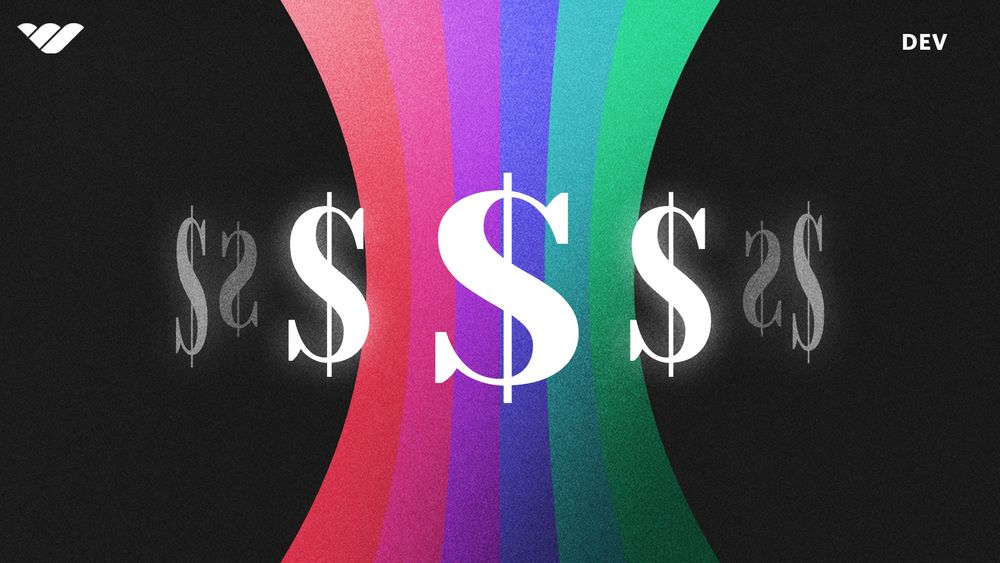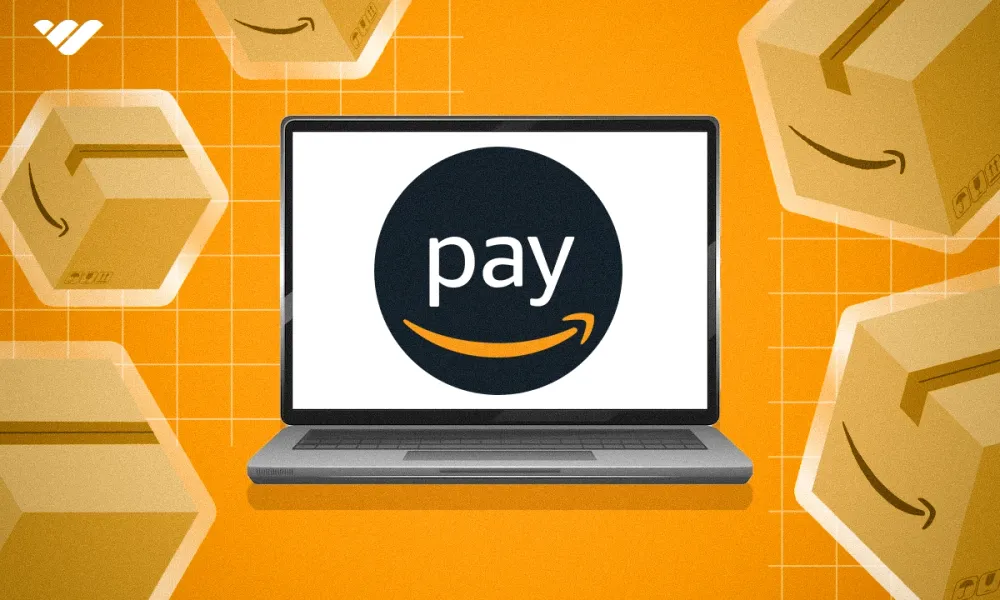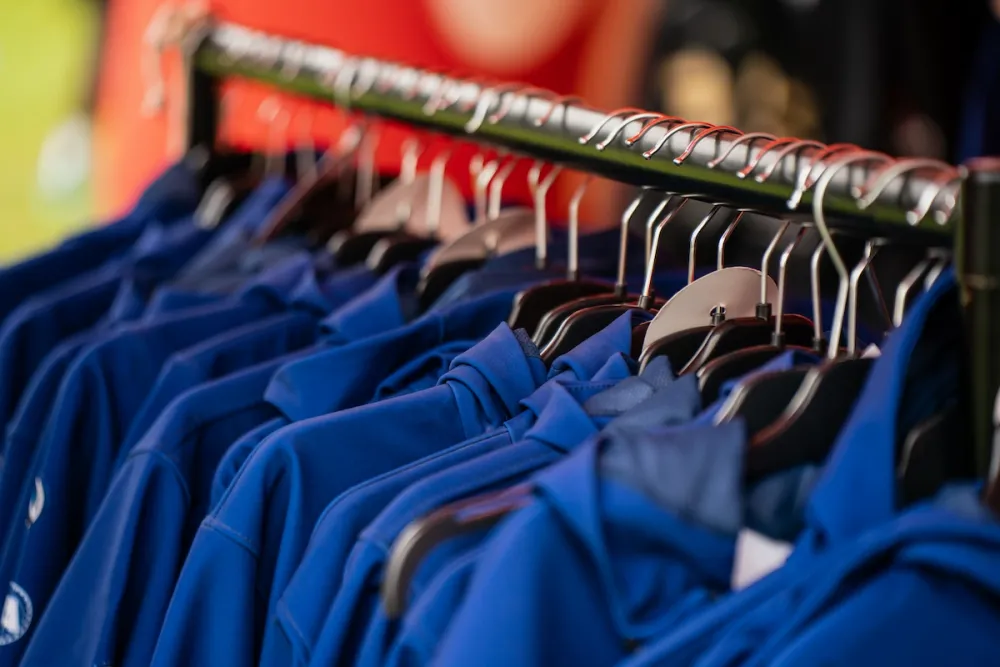You can start an online store without holding any inventory with dropshipping - a business model where suppliers handle the stock and shipping for you. This step-by-step guide walks you through how to launch, run, and scale a profitable dropshipping business from scratch.
Want to start selling online but don't have thousands of dollars for inventory? You don't need it. Dropshipping lets you launch a store without buying or storing a single product - and you can be up and running this week.
What is dropshipping?
Dropshipping is a retail fulfillment method where the store owner doesn’t hold physical inventory. This is because the supplier takes responsibility for all aspects of fulfilling the product. This includes storage, picking, packing, shipping and in many cases, returns.
This model has a heap of benefits for owners, not just delegation and storage, but also budget, as dropshipping also makes it possible to sell inventory without investing any money upfront.
As well as this, it also gives you the flexibility to sell products from multiple niches and suppliers, in turn expanding your market reach. It also grants owners flexibility in terms of location, as dropshipping businesses can be run from anywhere with a stable internet connection.
Ronnie Jourv from Savage Ecom
You probably scroll through ads on Facebook and Instagram all the time. You ever wondered who's actually making money from those? It's not massive companies – it's people like you and me.
— Ronnie from Savage Ecom
How dropshipping works
Here’s an introduction to how the dropshipping model works, with each of the essential steps broken down:
- You choose a product you want to sell or a niche you’re interested in. It doesn’t matter what category the product falls into, whether that’s phone accessories, or fashion, as long it features a dedicated customer base.
- After you’ve chosen your product/niche, you’ll locate a supplier who offers dropshipping services. For those who are just getting started with dropshipping, platforms like AliExpress, SaleHoo, and Temu are good starting points.
- After finding a seller, it’s time to set up an online store. It needs to be visually appealing, as well as easy to navigate, and optimized for conversions. Buyers will then place orders via the online store.
- Once a customer places an order, you will forward the details to the supplier. You pay the wholesale price (what your supplier charges for the product) and keep the difference between your set retail price and the wholesale cost.
- The supplier then picks, packs, and ships the product directly to the customer. Sometimes, the supplier will provide you with a tracking number, which you can use to follow the shipping process.
Dropshipping is a great way to establish yourself in the world of ecommerce, but, as with any new venture, there are a few things to consider before diving in.
Dropshipping guides & resources
How to start an online store without inventory
Now you know how dropshipping works, let's explore how you can start your own online store without inventory - from product research all the way through to listing your products and marketing your business.
1. Product research
Product research will be the foundation of your business. You can do product research for free with these tools and platforms:
Google Trends

One of the most tried and tested methods for generating ideas, Google Trends can provide insight into consumer trends across the globe.
It’s a completely free tool that allows you to track a trend’s trajectory, giving you important insights into niches and product categories. If that product or category is experiencing a surge in search interest, you’ll know it’s a good time to capitalize on that demand.
Google Trends also provides location insights, so you’ll see where a product is generating the most interest geographically. This is great for targeting specific test markets, and customizing your marketing strategies based on region-based demand.
Plus, Google Trends can also help you spot seasonal trends. So, for example, products or categories related to the holidays might experience a surge in popularity at particular times in the year, which can help you plan product launches and promotions.
Social media

Social media is another powerful tool for dropshipping research, as it gives business owners real-time insights into trends, consumer behavior, and product preferences.
Platforms like TikTok will often showcase viral products that are generating a lot of interest. By paying attention to what these brands, influencers, and users are posting, you’ll be able to spot emerging products and niches.
Social media platforms allow you to interact directly with potential customers. This can help you gauge interest, ask questions, and look for feedback on products before you decide to buy stock.
It’s also incredibly easy to conduct product research on social media, simply by acting as a customer. Search for terms like ‘Must have beauty products’ and ‘Best products for (current season)’, and take note of what appears. You can use this information to follow a funnel to a dropshipping store.
Make note of products that could be sourced from suppliers, then once you have a list of products you want to pursue, you can start sourcing them.
Bestseller lists
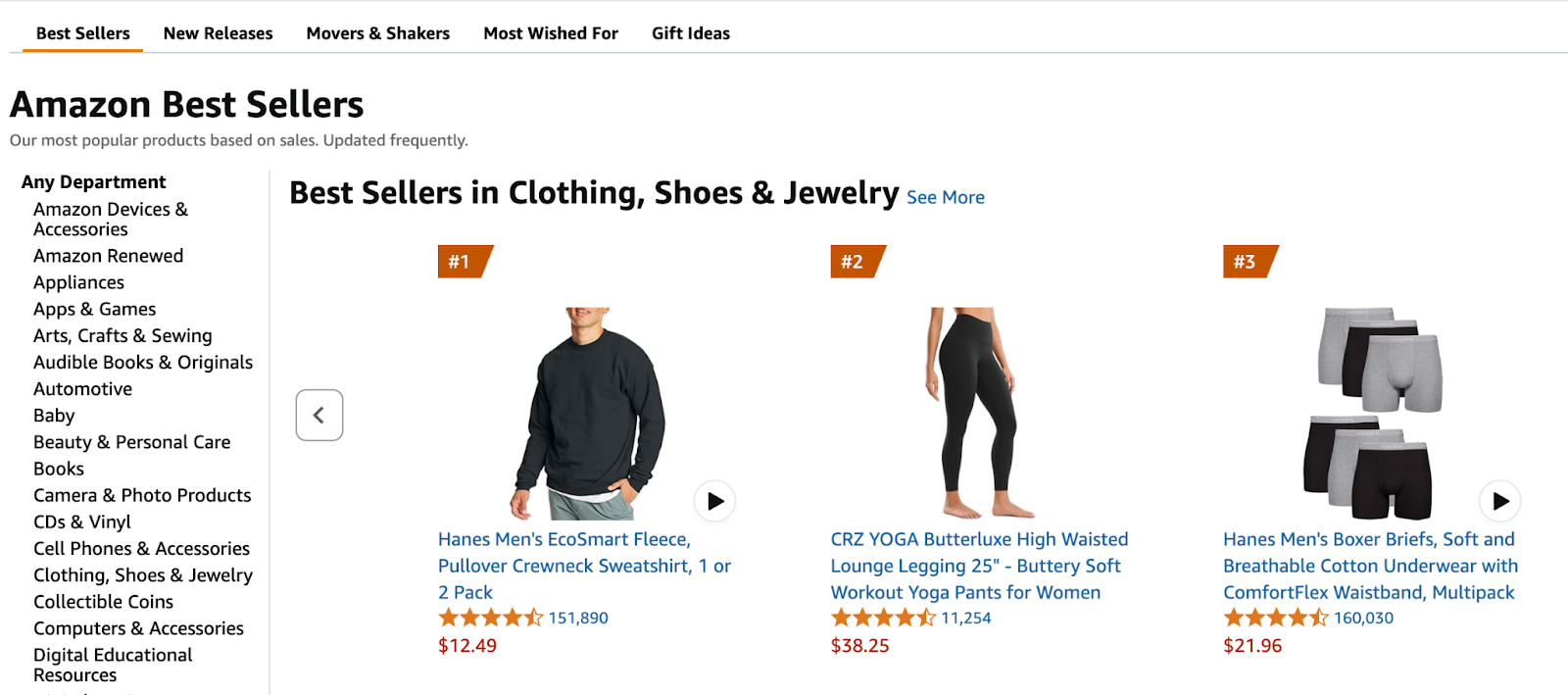
Bestseller lists like the ones found on Amazon are another great tool for sourcing potential dropshipping products. These lists are a great tool for identifying consumer preferences and purchasing behavior, ultimately helping you pinpoint items generating high demand.
Amazon, eBay, and Shopify all provide sales performance metrics, allowing you to view detailed sales data, including how frequently a product is sold or how it's ranking over time. You can access the Best Seller Rank (BSR) on Amazon, sold listings on eBay, and Shopify Analytics.
By monitoring trends regularly, you can stay ahead of the curve, and adapt your store’s listings in tandem.
Ads
Pay close attention to the ads that are being served to you. Many dropshipping stores have generated success to the point where they’re able to utilize large ad budgets.
So, if you spend enough time scrolling through social media, you’ll eventually be shown ads for products fulfilled through dropshipping. It’s not always clear whether or not the product is being drop-shipped, but there are a few ways to tell:
- Stock photos: Many drop-shipped products use stock photos from suppliers, which usually look generic and can be found across multiple sources on the internet.
- No clear branding: Drop-shipped products will lack clear branding, or just be labelled genetically e.g. ‘Wireless Earbuds’ instead of recognizable brand names like Apple or Samsung.
- Reverse image search: You can use the Google Reverse Image Search function to see where else the product images appear. If the same images are found in many different ads or stores, it’s most likely a dropshipping product.
💡 Top tip: If you find a great product idea in real life, but it doesn’t come from a recognizable source that’s easy to pinpoint, Google Lens can be a great tool for uncovering unidentifiable products. To use Google Lens, simply load the app and take a screenshot of the object. Google will use image intelligence to find the same or similar products, along with links to where they’re currently being sold.
You can then use this to cross-reference the product with listings from dropshipping websites to find new sales opportunities.

For more information on finding dropshipping products, check out these guides:
Finding dropshipping products guides:
2. Find your supplier
Now it’s time to find a reputable supplier you’re comfortable doing business with regularly. You can spend money on a vetted database to locate suppliers, but there are other ways to find information for free.
Networking
One of the most traditional ways to find suppliers is by networking with sellers face-to-face at trade shows and wholesale events. You can attend industry-specific events or general dropshipping-focused trade shows. Some of the best dropshipping events take place in China–Shenzhen, where you’ll be able to find trending products to test early before they hit worldwide markets.
Alternatively, if you’re not able to attend in-person events, you can simply contact manufacturers directly. Just Google the name of the product or category and dropshipping supplier to locate contact details.
You can also use B2B platforms like ThomasNet (for U.S.-based suppliers) and Global Sources list manufacturers and wholesalers to find dropshipping services.
Public groups
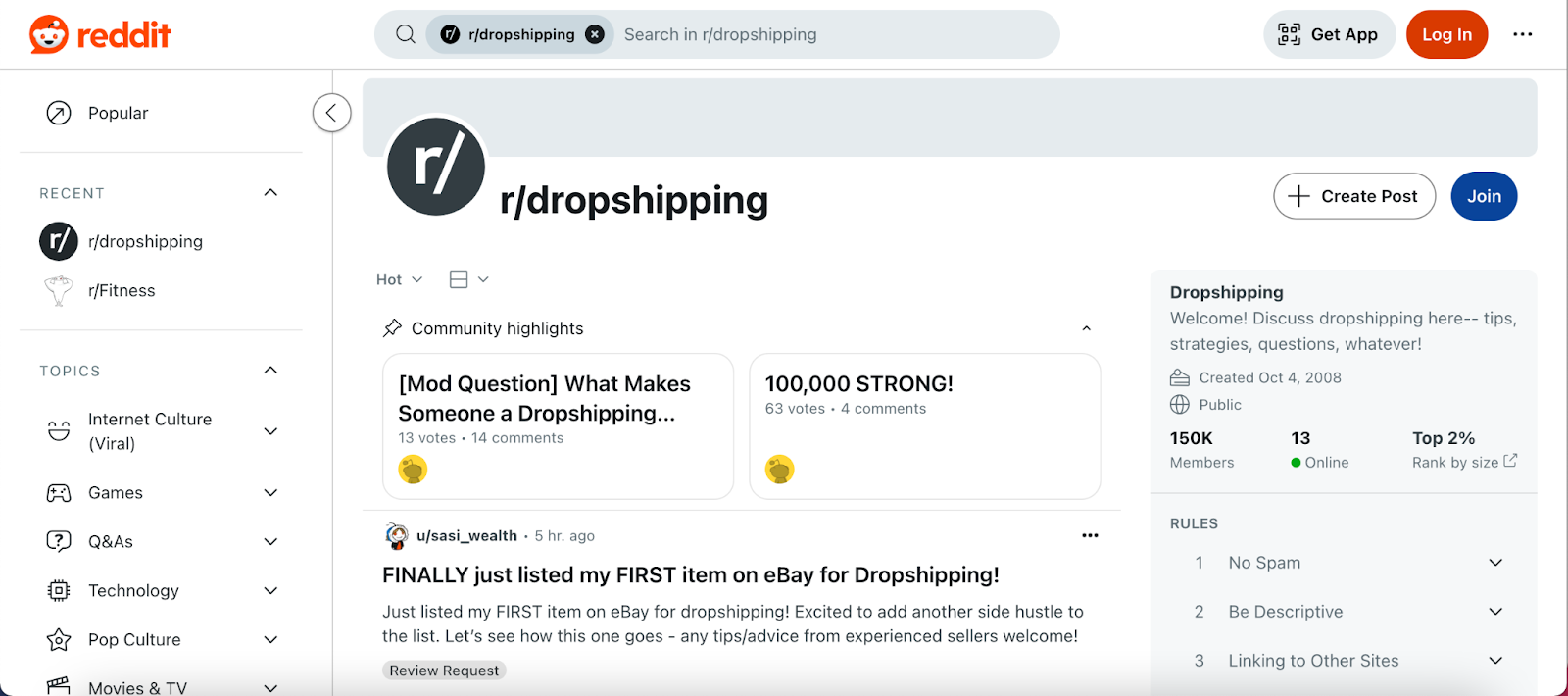
You can also leverage the power of community to find your ideal dropshipping supplier. Search for subreddits, Facebook groups and local meetups that are focused on dropshipping. If you can’t find a suitable thread with recent posts asking about suppliers, make one yourself.
If joining a dropshipping community is something you’re interested in, make sure to check out our list. Here, we take a look at the ‘Best dropshipping Discord servers’ you can sign up to today. You’ll find each community’s top features along with why it’s a good idea to join each of them.
Public ecommerce supplier platforms
An alternative method for locating suppliers is to independently explore public ecommerce supplier platforms. A great example is AliExpress, which hosts a vast array of suppliers across various specific niches.
AliExpress is one of the most popular dropshipping platforms. The marketplace on AliExpress is incredibly vast, and includes a variety of products that can be used for dropshipping. Plus, it’s completely free to contact sellers.
Temu, DHGate, and CJ Dropshipping are some other examples of popular dropshipping suppliers. Bear in mind, however, that some users featured on these platforms have minimum order quantities, so make sure to check these details before committing to a product and supplier to ensure they align with your dropshipping model.
Though it’s not considered to be as popular, some sellers on eBay offer dropshipping as a business model. Sift through their profile’s feedback to figure out how they operate, and read customer testimonials to get a better picture of their offerings.
💡 Top tip: When testing suppliers, make sure to start small, ordering a few items to begin with to help mitigate risk and potential let downs. Read through our guide to finding the best dropshipping suppliers.
3. Order product samples
Before you decide on the products you want to sell, purchase a physical to conduct quality testing. This not only allows you to check the integrity of the packaging and the functionality of the product itself, but also allows you to simulate the customer experience as a whole.
Take note of the shipping time and if it’s as quoted, and when the product arrives, scrutinize everything just as a customer would.
If you’re looking for some more inspiration, we’ve got a full list of the top in-demand products to sell right now. We show you how to identify these products, define the most profitable trending products guaranteed to stand the test of time, and give you information on how to start selling them online.
4. Setting up your online store
Now you’ve found a supplier for your dropshipping business, it’s time for the fun part - setting up your online store. The ideal platform for your dropshipping business will depend entirely on your target audience, along with your long-term business goals.
Let’s take a look at some of our top picks, along with a summary of each option to help you make the best decision.
Your own website
Creating your own website is a great option if you’re looking for more control over your brand, without having to pay a hefty monthly fee. Though getting this done might need some tech skills or involve some costly outsourcing, it will give you complete customization over your storefront, helping you to stand out as an authority in your niche.
Amazon
With a huge storefront that boasts massive reach and brand credibility, Amazon is an ideal dropshipping platform for a lot of dropshipping sellers.
Bear in mind that if you choose to sell via Amazon, the site does have some pretty strict rules regarding dropshipping, so you’ll need to make sure to read these carefully.
For example, as the seller, you are responsible for customer service, returns, and handling any issues that arise with an order. Even if you’re using a third party, any problems, such as late shipments or defective products, are considered your responsibility.
Amazon FBA is a good alternative to dropshipping on Amazon. It is a paid, premium service for sellers aimed at increasing efficiency and streamlining all aspects of fulfillment so that store owners can scale without worrying about having to store, pack, pick, and ship their own inventory.
Shopify

Shopify is another solid option for those looking to establish a dropshipping website. It’s incredibly user-friendly, making it easy to set up and launch your dropshipping store. You don't need any specialized coding or design experience to make a professional-looking website using the platform.
Shopify integrates with several popular dropshipping apps, including Oberlo, DSers, Spocket, and Printful. These apps make it easy to monitor every aspect of fulfilment, including automating orders that have been placed, and tracking inventory.
Shopify also comes with a range of handy in-built SEO tools, including SEO optimization, email marketing, discount codes, and abandoned cart recovery. These tools can help drive traffic to your storefront.
Finally, Shopify also boasts 24/7 support, with a team of dedicated workers always at hand to help solve any potential issues. So, whether you run into technical issues or have questions about setting up your dropshipping store, there’s plenty of help at hand.
TikTok Shop
TikTok has over a billion active users, making it a powerhouse for reaching a wide, thriving audience base. It’s considered to be one of the most influential social media platforms in dictating trends and buyer habits, making it a great space for selling drop-shipped goods.
You’ll need to create a business account to get started, however, the good news is there’s no minimum threshold of followers required to be able to open a TikTok shop as a seller. But, you must be located in the US, UK, Indonesia, Malaysia, Thailand, Vietnam, Philippines, or Singapore to get started.
TikTok Shop allows direct product integration, so you can sell directly via the platform. TikTok Shop allows product links in videos and live streams, so you can easily engage users and prompt immediate purchases. This creates a seamless shopping experience for users without ever having to leave the app.
5. Create product listings
Now your store is all set up, it’s time to start listing your products. When it comes to your online storefront, one of the most important aspects of the overall layout and design is the product listing page.
Make sure no matter which platform you choose, that it allows for the creation of listings that are easy to browse and attractive to look at. This is important if you plan to stock multiple products.
When creating listings, make sure to choose images that present the highest quality possible. If you’re not satisfied with the images provided by your supplier, then you can take some new photographs yourself.
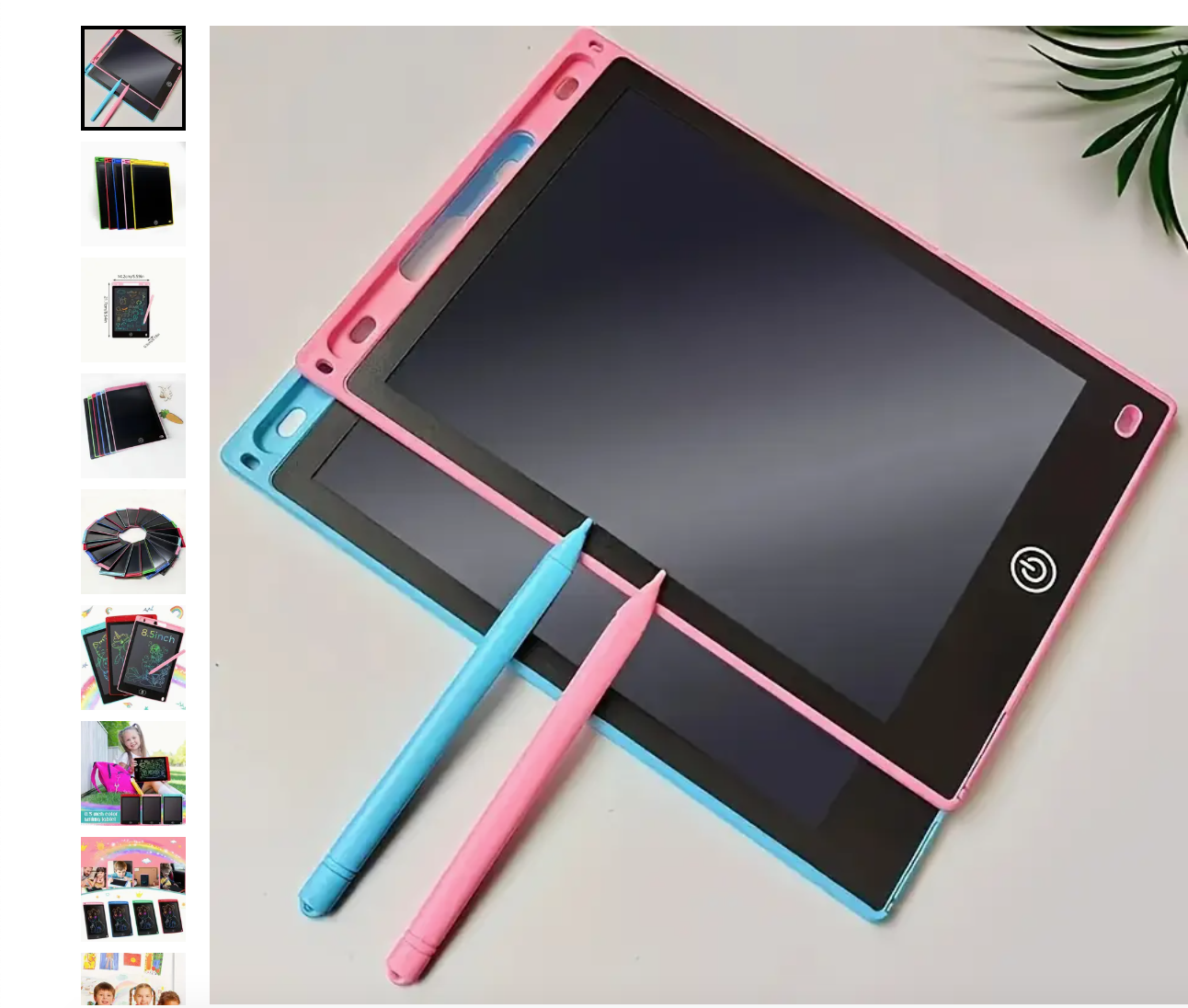
To take professional product photos, make sure to:
- Use a tripod: While this might be optional for some photos, we highly recommend using a tripod when taking product pictures. Tripods ensure your product photos are clear and sharp, and also prevent blurring associated with shaky cameras.
- Plain background: When taking images of your products, plain backgrounds are always best. By keeping things simple and clean-cut, you’ll help the product stand out while avoiding any unnecessary distractions in the background.
- Natural light: To give images a softer, warmer look, take your photos in a space with plenty of natural light. Place your product perpendicular to a window so that light is evenly distributed throughout.
- Edit: Even if you’ve done everything possible to ensure you take the best images possible, chances are you’ll still need to perform some editing afterward. There are a ton of editing software programs out there, but we recommend using Adobe Photoshop. It’s considered one of the more user-friendly programs, plus it has all the tools you need to create the perfect product images.
After you’re satisfied with the images for your product listings, whether they’re stock images, or images you’ve taken yourself, you can upload them to your product listing page. As well as images, you’ll need to create attractive descriptions along with easy-to-follow CTAs for listings.
Some platforms include direct integrations for products and their images, as well as descriptions directly from the supplier so you can automate the process. However, we’d recommend double-checking these, and making sure they’re up to date and sound as appealing as possible.
6. Register your business
Though you can informally establish your business by using marketplaces like Aliexpress to source products, it is a good idea to properly register your business as early as possible. This will bring you a lot of benefits further down the line.
One of the key advantages of formally registering your business is that you'll be able to work more freely with a range of different suppliers. Some suppliers will only work with registered businesses, so you don’t want to shut out these opportunities.
Registering your business also ensures you comply with local, state, and federal regulations, which will help you avoid legal issues further down the line. Plus, if you set up your business properly early on, you’ll avoid complications when tax season comes around.
7. Marketing
Now we come to what is debatably the most important step in establishing a successful dropshipping business: marketing. There are several different ways to approach this, however, we’d recommend switching things up and using a few different methods.
After all, no matter how good your product or store is, you won’t make any sales until you learn how to reach as many potential customers as possible.
Social media
Perhaps one of the easiest and most effective ways to market your business is on social media. Since it’s totally free to create an account on any popular platform, including TikTok, Instagram, YouTube, and Pinterest, getting started couldn’t be any simpler.
To get started, focus on creating engaging, high-quality content that showcases your products in a shareable, entertaining way. You can post a wide variety of content styles, including product demos, customer reviews, behind-the-scenes looks, and user-generated content. You can also use paid advertising through targeted ads to reach tailored audiences based on their demographics.
It’s also a good idea to collaborate with micro-influencers to expand your reach, and harness the power of hashtags to enhance your discoverability - like this seller has done:
Make sure to engage with followers regularly, with consistent posts and direct replies to messages. This will help build trust, drive traffic, and ultimately boost your business sales.
Online forums
Similar to social media marketing, online forums are another free way to spread word about your business. Targeted spaces on Reddit, Facebook groups, and Quora can be particularly lucrative environments to interact with potential customers.
To make your presence known, be sure to contribute to conversational topics and add value by offering helpful and relevant advice. Wherever possible, try to suggest your storefront or product as a solution.
Email marketing

Email marketing is one of the best ways to foster relationships with customers, as well as build brand loyalty.
To get started, build an email list on your website, offering incentives like discounts or freebies in exchange for your subscribers’ email addresses. Once you start building your list, start sending personalized emails to customers, including pertinent news about your business, including product releases and stock updates.
You can also offer informational or advice-driven sections based on products you have on sale. For example, if your store focuses on selling beauty items, you can include some make-up based tutorials for subscribers showing them how to create different looks using products bought from your store.
Email marketing can also be used to automate abandoned cart reminders to recover lost sales, as well as follow-up emails after customers have purchased an item to encourage reviews. If a subscriber has bought items from your storefront, but has been inactive for a while, re-engagement campaigns are a great way to reignite interest.
8. Find and use the right tools
Though the idea of dropshipping might seem overwhelming at first, you don’t need to do everything yourself. There are a hoard of tools out there you can use to aid the success of your business. Here are some handy integrations to help you get started:
- Inventory management tools: Even though you’re not dealing with physical stock yourself, you can still run into issues with suppliers. It’s good to look into tools that synchronize your inventory with your supplier, preventing customers from ordering out-of-stock products.
- Automation tools: Automation tools cover a wide range of different functions that can help streamline dropshipping processes. These include product listing creation, order processing and autoresponders to answer common customer questions and queries.
- Spy tools: Designed to find relevant data surrounding competitors, spy tools can check out things like ad strategies, alerts for new products being stocked, and find relevant data surrounding sales volume. Some popular options include SEMrush, Ahrefs, Similarweb, Kompyte, Prisync, and VisualPing which provide insights into competitor pricing, website traffic, and product listings.
- Customer service tools: As your business grows, it can be difficult to keep up with demands associated with customer service. We’d recommend downloading a chatbot, a computer program that uses artificial intelligence to mimic human conversation. Chatbots can address common concerns and answer simple questions without the need for human intervention.
9. Start scaling!
Now it’s time to start scaling your dropshipping venture. The best way to do this as a dropshipper is to expand your product line. Focus on a winning product with steady sales and satisfied customers, then start searching for similar or complementary products your customers will love.
As your business continues to grow, you may even consider entering different regional markets. When your current region has proven demand for your products, and you have the tools to handle bigger orders, expanding to different regions will give you a larger customer base, ultimately boosting your sales.
Getting a head start in new areas can establish your brand as a frontrunner in different markets, giving you the edge over competitors who might come in later.
If you want to learn more about expanding your business without spending a fortune, we’d recommend checking out our guide: ‘Bootstrap your business: How to grow your business without breaking the bank.’ You’ll learn how to take control of your businesses’ finances, and make money doing what you love.
Free dropshipping suppliers
You can start dropshipping for free using platforms like AliExpress, DHGate, Printful, Wholesale Central, Spocket, Temu, Taobao, Oberlo, and Whop - all of which let you source products without paying upfront or committing to subscriptions.
Below, we’ll take a closer look at each of these free suppliers, what they offer, and how they compare.
AliExpress
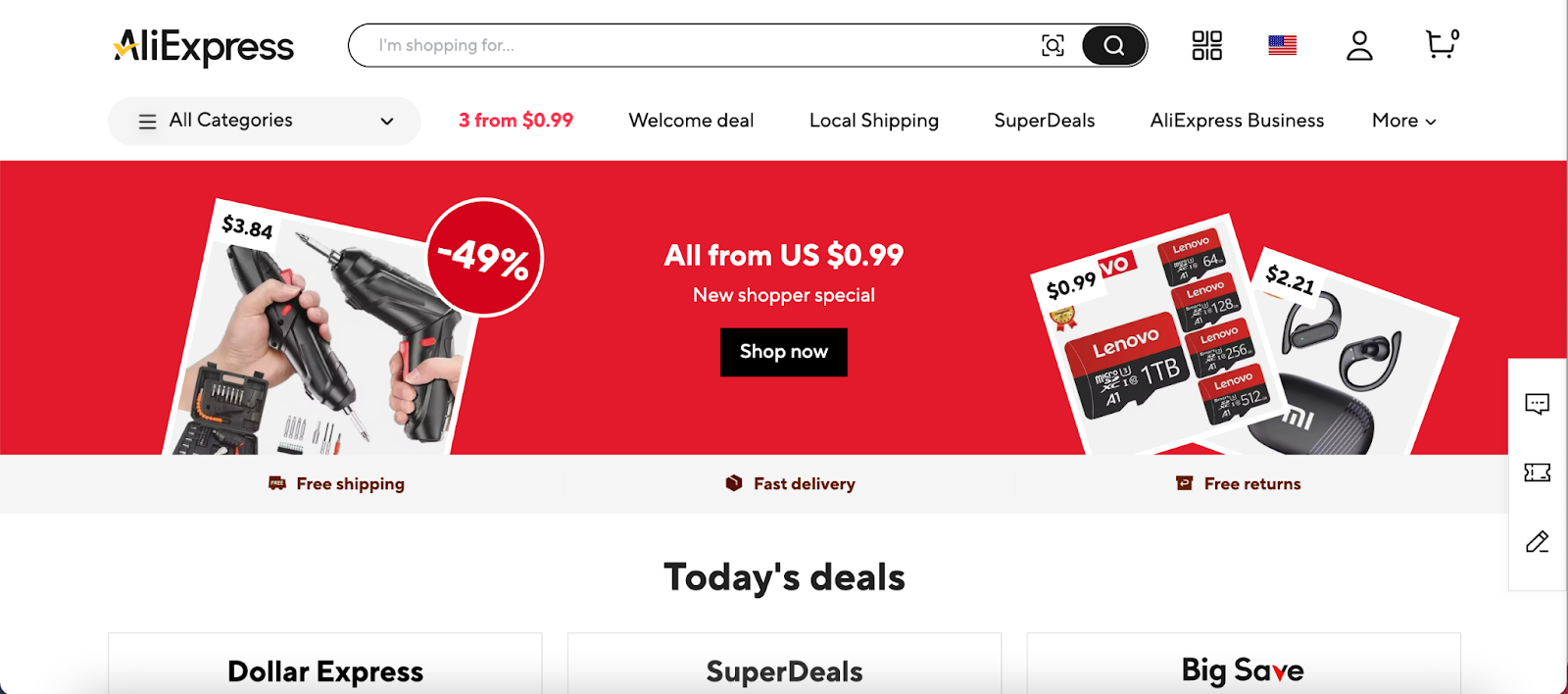
AliExpress is one of the popular choices for novice dropshippers. It’s a great fit for all budgets, with products ranging vastly in price scales. It houses a diverse range of products, with unique and interesting offerings that make perfect dropshipping items.
It also has a public review system along with messaging features that make it easy to contact suppliers.
However, the vast range of products can prove overwhelming, and you’ll need to filter through a hoard of suppliers and read through reviews to vet sellers before ordering samples.
Shipping usually takes approximately 15-45 days, with standard shipping being the most common and affordable option. Shopping times can sometimes extend past 45 days depending on the destination and customs processing.
DHGate
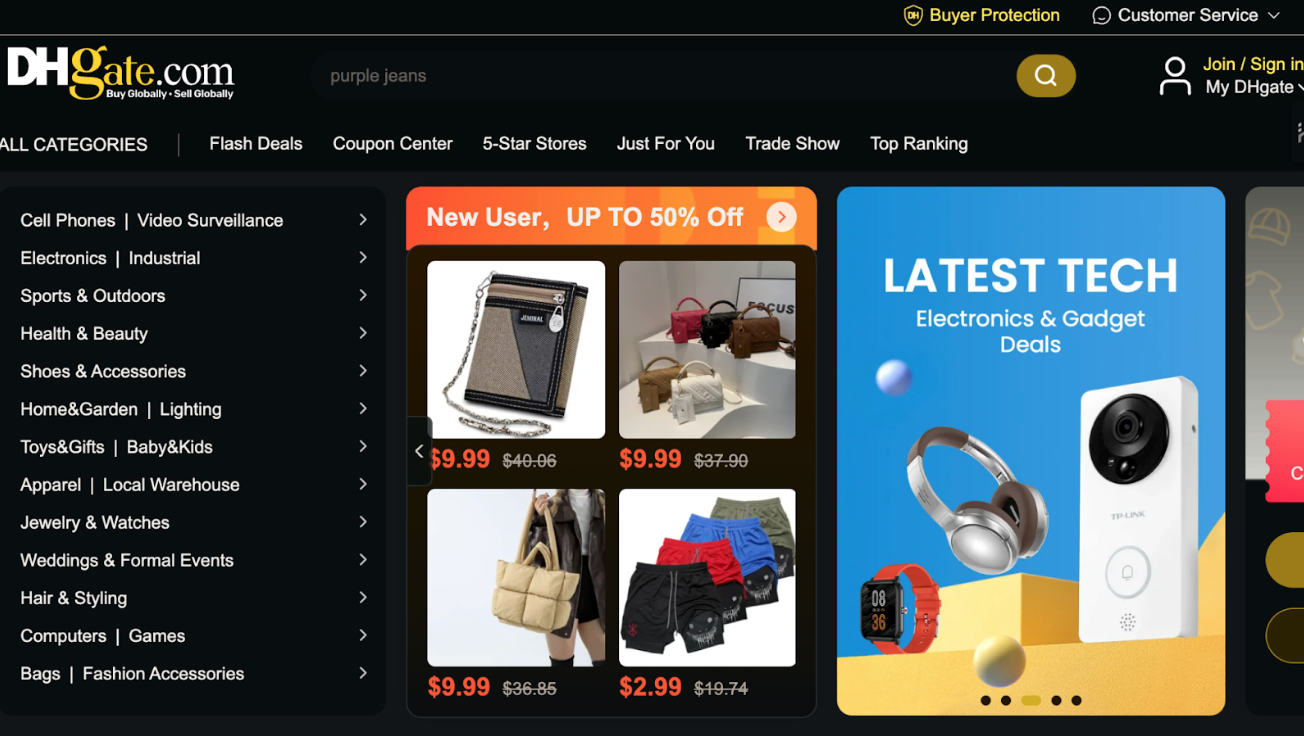
DHGate is a Chinese marketplace that was first established back in 2004. It’s a popular AliExpress alternative for entrepreneurs, and is primarily used as a B2B solution for sellers wanting to order products in bulk.
It’s easy to vet sellers on DHGate, as the website has comprehensive reviews from fellow buyers. It’s great for sourcing goods in the electronic and gadget niches, so if this is a category you’re interested in exploring, DHGate is definitely worth checking out.
Similar to AliExpress, one of DHGate’s downsides is that it takes a lot of time to sort through the extensive list of categories and suppliers. Supplier quality can also vary significantly, because of the vast amount of sellers currently using the platform.
Orders typically take 10-30 days to deliver, with both options for standard shipping and ePacket. Faster shipping can be arranged but this depends on the individual seller.
Printful

Printful is a great option for putting your own stamp on products. It’s one of the top print-on-demand options, with a collection of over 300 different products that can be customized on demand and shipped directly to customers.
Some of the most popular options include t-shirts, hoodies, and leggings, as well as accessories like hats, tote bags, mugs, and phone cases.
The pricing, fulfilment times, customer service, and product quality are all exceptional, making this a fantastic option for those looking to sell customized products without the need for personal production and fulfilment.
Production usually takes 2-7 business days before shipping for print-on-demand, depending on the item. Once products are shipped, US domestic shipping takes approximately 3-7 business days, while international shipping usually takes 5-20 business days.
Wholesale Central
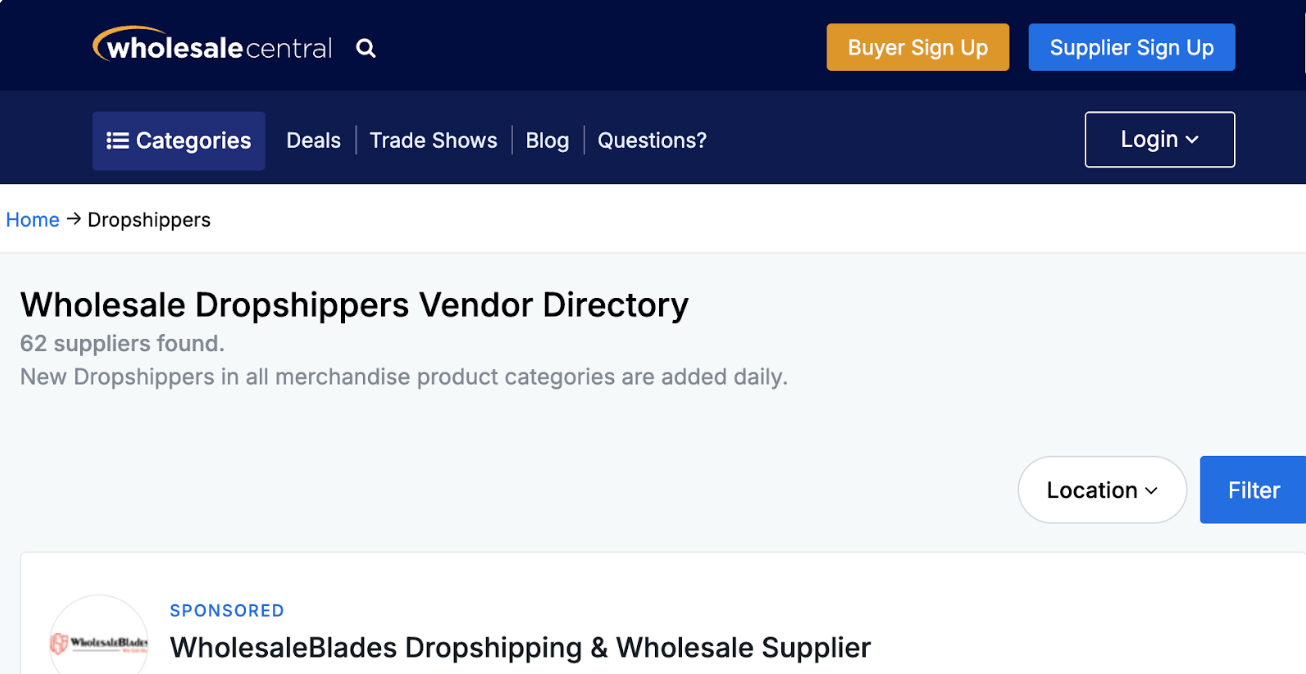
Wholesale Central is a free directory with a diverse selection, including domestic options as well as overseas suppliers. It provides access to thousands of suppliers across numerous categories, from electronics to apparel to beauty products, so you can explore multiple niches for your dropshipping venture.
Suppliers listed on Wholesale Central are also vetted, which reduces the risk of working with untrustworthy sellers. The platform also boasts detailed product listings along with specifications and pricing, helping you make informed decisions on every purchase.
As you may have guessed from the brand’s name, Wholesale Central typically serves the wholesale market, but with some effort and outreach, it’s totally possible to find a supplier that’s willing to dropship for you.
Wholesale Central also has live trade shows you can attend, helping you to network and build profitable business relationships.
Standard, same-country shipping usually takes 3-7 business days for most suppliers, while international orders can take anywhere from 7-21 business days.
Spocket
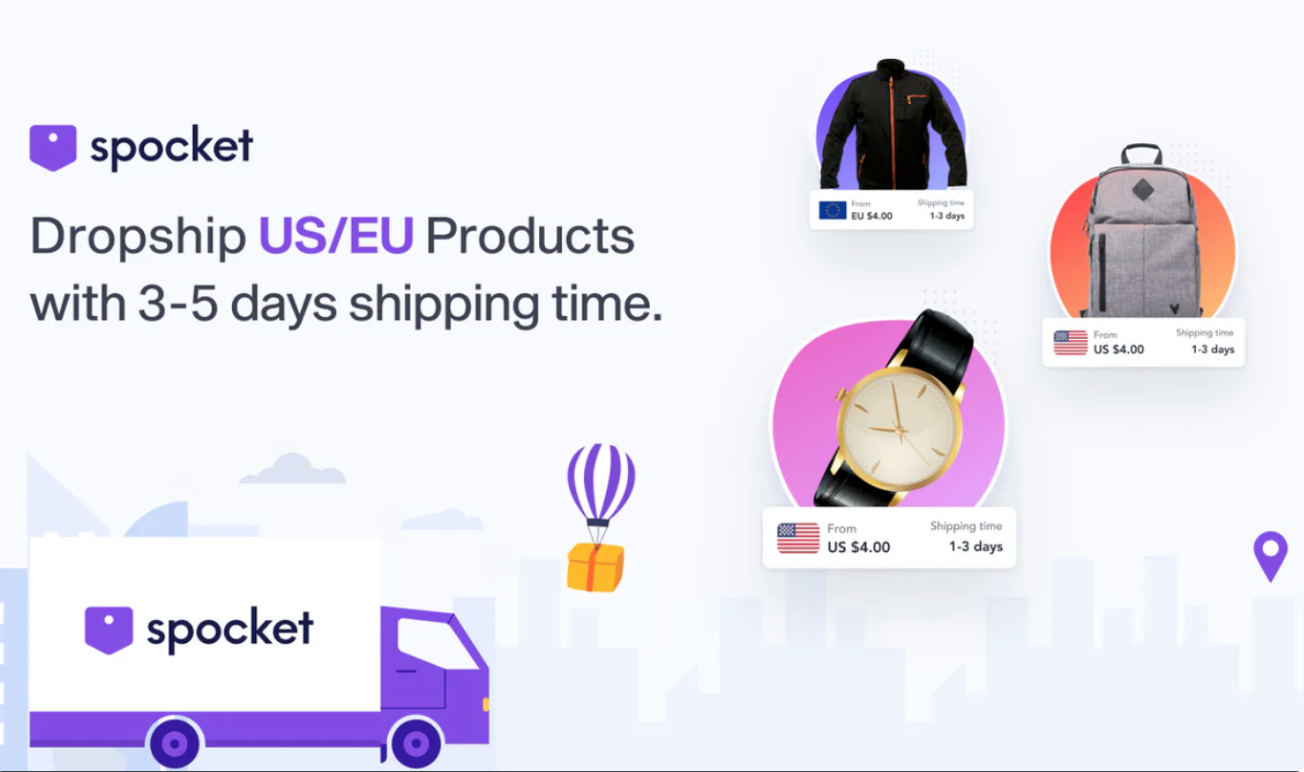
The product catalog featured on Spocket features a wide range of items sourced directly from the US and EU, with fast shipping already priced into the reasonable product cost. This is an excellent solution for many drop-shippers, as products ordered from China come with waits that can be in the two-week range or even longer.
Expedited shipping rates often come with a hefty price tag, making it costly for business owners. Thankfully, Spocket, a dropshipping app that integrates with Shopify, easily solves this issue.
Spocket’s vast range of Western suppliers also comes with other benefits, with products generally exhibiting higher quality and being more likely to meet the standards that customers expect, reducing the risk of returns and customer dissatisfaction.
Finally, Spocket provides real-time updates on inventory levels and pricing, so you can guarantee product listings are always up-to-date, reducing the risk of selling out-of-stock items.
Shipping times usually only take 2-7 days.
Temu

Temu has risen in popularity exponentially over the past few years. It offers incredibly low product prices, making it easier for drop-shippers to sell at competitive prices and maintain good profit margins. It also features products across a multitude of categories, including fashion, electronics, home goods, beauty, and more.
Another great feature of Temu is that the platform often offers bulk discounts and promotional deals, helping dropshippers lower their costs, leading to even higher profitability.
Furthermore, Temu doesn’t require buyers to meet minimum order quantities for the majority of products, making it ideal for dropshipping.
Because it’s considered one of the biggest up-and-coming dropshipping platforms, it’s attracting a wealth of suppliers from various industries. As the platform grows, it’s likely to offer an increasing number of suppliers catering to different niches, ultimately giving buyers more trending product options to explore.
As most items arrive from overseas, shipping typically takes 10-30 business days, depending on location and local customs procedures.
Taobao

Taobao was first launched back in 2003 by Alibaba as a marketplace for a wide range of items and is positioned more as a direct-to-consumer platform for purchasing items individually.
It’s also become a fast favorite among dropshippers. This is because the platform is generally considered to be much cheaper than alternatives like Aliexpress and often features more unique items, especially gadgets and accessories.
Many Taobao sellers offer no minimum order quantity (MOQ), which makes it ideal for dropshipping. This allows purchasers to buy products one at a time, rather than needing to buy in bulk.
Some Taobao suppliers offer customizable products (like branding or design modifications), which is an added benefit if you’re interested in putting a personal touch on items.
However, because the platform was made to serve the Chinese market, international shipping can prove difficult. Plus, dropshipping requires third-party assistance.
Domestic shipping to China only takes 2-5 days, but international shipping generally takes much longer than other similar Chinese-based platforms like Temu or AliExpress, as most Taobao suppliers only serve the domestic market.
Oberlo

Though Oberlo isn’t considered to be a dropshipping platform in the traditional sense, it is incredibly handy as a resource for sellers searching for products to dropship.
Oberlo is an app that integrates with platforms like Shopify and Aliexpress, helping you streamline the dropshipping process.
You can easily import products from suppliers directly into your online store with just a click of a button. You can also automate product updates, including price inventory changes so that all your listings are up to date, helping you stay organized.
Oberlo lets you check out real-time dropshipping statistics, which assist in discovering top trending products. Oberlo also has an incredibly intuitive, user-friendly interface, making it easy for beginners to get started.
If you’re on the hunt for more dropshipping platforms for your online business, we’d recommend checking out our full list, ‘AliExpress Alternatives.’ You’ll find a stack of great options, including websites that are stacked with full product catalogs, curated directories, and easy-to-integrate apps
Whop
Whop is the best place to start and scale any online business - including digital dropshipping, one of the easiest and most profitable ways to sell online today.
In digital dropshipping, you sell digital products - like courses, templates, memberships, software, or guides - without handling any inventory or manual fulfillment. When someone buys from your store, their purchase is delivered automatically, giving you instant revenue and your customers instant access. There are no shipping delays, packaging costs, or physical stock to manage.
That’s exactly what Whop is built for. It’s a modern, all-in-one marketplace where creators, entrepreneurs, and business owners can sell anything online - from digital offers to hybrid and service-based products.
Setting up your Whop store takes just minutes and is completely free. The platform includes a built-in payments system that accepts credit cards, PayPal, and even crypto, plus automation for order delivery, analytics, and customer management.
With Whop, you can turn your ideas into digital products, list them in front of millions of buyers, and scale fast, all without ever touching a warehouse or managing logistics.
Is dropshipping worth it?
Yes - dropshipping is still worth it in 2025, especially for beginners who want to start an online business without large upfront costs. It’s one of the easiest ways to test product ideas, build an online store, and generate income with minimal risk.
But, success depends on choosing the right niche, finding reliable suppliers, and building a strong brand that stands out in a crowded market.
| Pros | Cons |
|---|---|
| ✅ Low overheads: No need for inventory, storage, or shipping costs. | ❌ Market saturation: Popular products quickly become oversold. |
| ✅ No inventory management: Suppliers handle stock and fulfillment. | ❌ Limited control: Shipping times and product quality depend on suppliers. |
| ✅ Flexibility: Run your store from anywhere with an internet connection. | ❌ Customer service challenges: Returns and refunds can be harder to manage. |
| ✅ Organic reach: Leverage free traffic from platforms like TikTok. | ❌ Trend-chasing: Constantly shifting trends can reduce profit margins. |
| ✅ No product development: Sell existing products without creating your own. | ❌ Supplier reliability: Your success depends on consistent, trustworthy suppliers. |
Launch your dropshipping business today with Whop
If you’re serious about making real money online, Whop is where to start. It’s the all-in-one platform for creators and entrepreneurs to build, grow, and monetize any kind of online business, including dropshipping stores, communities, courses, and digital offers.
Join one of Whop’s top-rated dropshipping communities to learn from verified experts, get insider strategies, and access tools that actually help you scale. Or become a seller yourself - launching your own whop takes minutes, it’s completely free, and your products get listed in front of millions of potential buyers.
Whether you’re selling physical products, digital downloads, or exclusive memberships, Whop gives you everything you need to turn your ideas into income, fast.



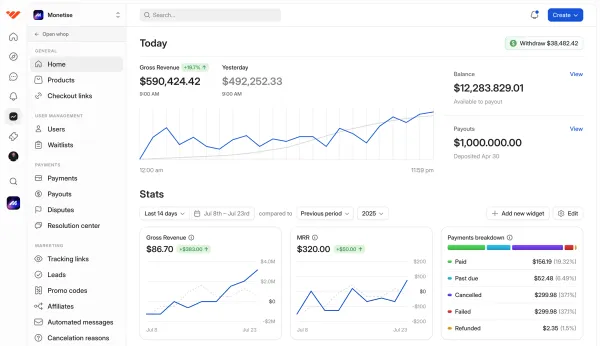
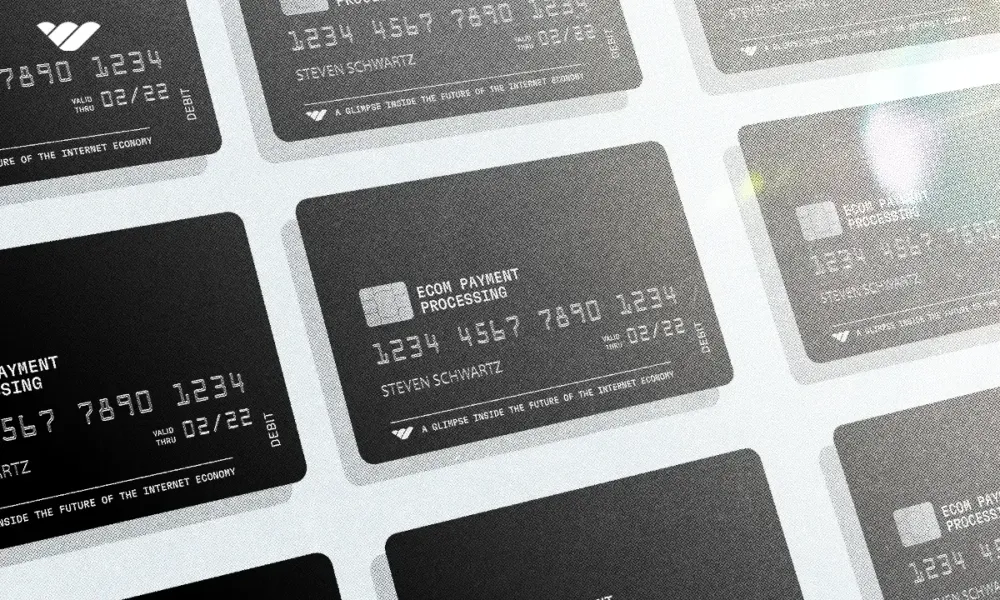
![8 best BNPL providers for your business [2026]](/blog/content/images/size/w1000/2024/08/X-Best-BNPL-Companies--buy-now--pay-later--for-your-business.webp)
![How to sell digital products without a website - ultimate guide [2026]](/blog/content/images/size/w1000/2024/02/How-to-Sell-Digital-Products.webp)


![12 best payment processing companies for ecommerce [2026]](/blog/content/images/size/w1000/2024/10/Top-10-Payment-Processing-Companies-for-Ecommerce-Feature-Image.png)

